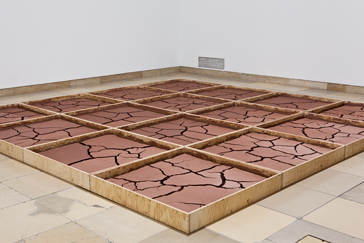
Born in 1946 in Harrisburg, Pennsylvanie (US). Lives and works in Harrisburg (US).

1971
wooden boxes, clay
121 x 121 x 15cm
Year of Purchase: 2012
In 1969, Alice Aycock visited one of the legendary national parks in the American West: Death Valley. Known for its record heat and lack of precipitation, this hyper-arid zone contains, among other things, the crystallized traces of a lake that evaporated several thousand years ago. First created in 1971, on the occasion of an exhibition of women artists,1 Clay breaks away from the glossy finish of minimalism as well as from the conceptual intellectualism currently in vogue. A real worksite, the installation consists of a wooden box into which the artist has poured a mixture of silver powder and water, creating a muddy substance subject to the processes of evaporation and cracking.
An ancestral modeling material, in the late 1960s the soil was the medium of anti-form sculpture and of ritual performance. At the height of the environmentalist movement,2 clay was also indicative of geological, rather than industrial, conditions. Two pessimistic mentors directed Aycock towards a recognition of the rubble rather than of a mythology of mother nature. One of them, her professor Robert Morris, in 1968 named a pile of refuse “Earthwork.” The other, Robert Smithson, impressed by the apocalyptic science-fiction novel Earthwork by Brian Aldiss (1965), organized an exhibition of site-specific interventions under the same title in 1969.3 Faithful to this expanded practice of sculpture, Aycock built mazes, traps, and underground galleries, something between landscape and architecture. Inspired by cybernetics and its systems theory, Aycock wrote her dissertation on the network of highways which, she claimed, is as organic as the circulation of blood or the brain’s wiring.
There are two paradoxical interlocking networks in Clay: the orthogonal grid of the box and the random cracks in the mud, respectively evoking an organizational system and uncontrollable scattering. While drought usually brings up deadly associations, Clay is a translation of a programmed catastrophe. A gigantic drying rack, the device is an attempt at creating a test-tube desert. Aycock rations water and soil, elements now considered to be scarce. After she had photographed, at regular intervals, the formation and dissipation of clouds ( Cloud Piece, 1971), the artist attempted to attract rainwater by a stretch of asphalt ( Asphalt Flat/Cloud Formation Project, 1972), confessing that she “always had had this megalomaniac fantasy that I could mess with the weather or the universe.”4
Hélène Meisel
1 Twenty-six Contemporary Women Artists, The Aldrich Museum of Contemporary Art, Ridgefield, CT, April 18–June 13, 1971, curated by Lucy Lippard. Featuring, inter alia: C. Kozlov, M. Miss, A. Piper, and J. Winsor.
2 The first Earth Day was celebrated on April 22, 1970 ; then, in June 1972, the Stockholm conference inaugurated the Earth Summits to come.
3 Earthworks, Virginia Dwan Gallery, New York, 1969, curated by Robert Smithson. Featuring: C. Andre, H. Bayer, W. De Maria, M. Heizer, S. Kaltenbach, S. LeWitt, R. Morris, C. Oldenburg, D. Oppenheim, and R. Smithson.
4 Alice Aycock in Lucy Lippard, Six Years: The Dematerialization of the Art Object from 1966 to 1972 (London: Studio Vista, 1973).